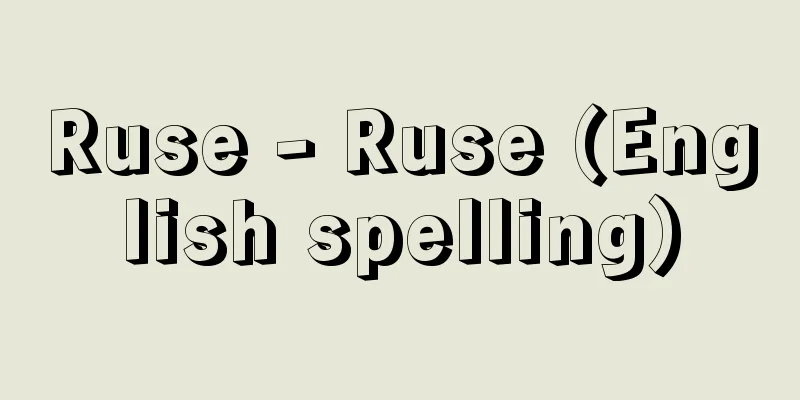Ruse - Ruse (English spelling)

|
The capital of Ruse County in northern Bulgaria. Population 178,435 (2001). A city on the Danube River. The country's largest hub for Danube river traffic. The bridge connecting it to Giurgiu, Romania on the opposite bank, is a two-tiered structure for rail and vehicle traffic, and is also a key point for land traffic connecting the former Soviet Union and Eastern Europe with the eastern Balkans and Turkey. The town's name comes from the 1st century Roman fortress Sexanta Prista (60 battleships). In 1388, it came under the control of the Ottoman Empire, and a powerful fortress called Rustyuk was built. It became a multi-ethnic and multi-cultural city, with mosques, Orthodox churches, Armenian Orthodox churches, and Jewish synagogues built. In 1864, it became the capital of the Danube region, which included the entire northern Bulgarian region, and when the reformist Mithkad Pasha took office, various reform attempts were made, such as an experimental farm that introduced agricultural machinery and the construction of a Central European style city that still remains today. At the time of independence in 1878, it was the most populous city in the Principality of Bulgaria. The machinery, metalworking and food industries are well developed, and the area is also known for its white wine. The city has a university, an orchestra and a theater, making it a cultural center of the region. The 1981 Nobel Prize-winning author Canetti was born in Ruse. [Kenji Terashima] [References] |Source: Shogakukan Encyclopedia Nipponica About Encyclopedia Nipponica Information | Legend |
|
ブルガリア北部、ルセ県の県都。人口17万8435(2001)。ドナウ川沿岸の都市。ドナウ河川交通の国内最大の拠点。対岸のルーマニアのジュルジュと結ばれた橋は、鉄道と車両用の二層構造で、旧ソ連・東欧圏とバルカン東部やトルコを結ぶ陸上交通の要所でもある。町は1世紀のローマの要塞(ようさい)セクサンタ・プリスタSexanta Prista(60隻の戦艦)に由来する。1388年にオスマン帝国の支配下に入り、ルスチュクとよばれる強大な要塞がつくられ、多民族・多文化の都市となり、モスクや正教会のほかに、アルメニア正教会やユダヤ教のシナゴーグも建設された。1864年に北ブルガリア一帯を含むドナウ州の州都となり、改革派のミトハト・パシャが着任すると、農業機械を導入した実験農場や今も残る中欧様式の都市建設など改革のさまざまな試みが行われた。1878年の独立時、ブルガリア公国で最大の人口をもつ都市であった。機械、金属加工業、食品産業が発達し、一帯で生産される白ワインでも知られる。市内には大学、オーケストラ、劇場があり、地域の文化的中心地となっている。1981年のノーベル賞受賞作家カネッティはルセ出身である。 [寺島憲治] [参照項目] |出典 小学館 日本大百科全書(ニッポニカ)日本大百科全書(ニッポニカ)について 情報 | 凡例 |
Recommend
Freikorps
…However, at the same time, contrary to the wishe...
Huskisson
British politician. After working in the governmen...
Indonesian Art - Indonesian Art
Indonesian culture dates back to the BC era, and i...
Millard-Gubler's syndrome
…In particular, in cases of brainstem damage, the...
Earth (myth) - Earth
...Balder (who shoots mistletoe at Baldr), Baal (...
YAG - YAG
Abbreviation for yttrium aluminium garnet. [Synon...
Cyclostomi
…The most primitive vertebrate fishes (Agnatha) w...
Vladikavkaz (English spelling) Владикавказ/Vladikavkaz
Located in the southwest of the Russian Federatio...
Kanpindo - Kanpindo
…Copper was a standard export item not only for p...
Sumitomo Zaibatsu
One of the three major zaibatsu before the war. B...
Iwase [town] - Iwase
A former town in Nishiibaraki County, western Ibar...
Satsuma [town] - Satsuma
A former town in Satsuma County in northern Kagosh...
Search of the house - kataku sosaku
It refers to entering a person's residence to...
Minahasa people - Minahasa tribe (English spelling)
A Proto-Malay ethnic group living on the Minahasa ...
In-kind contribution
Contribution of assets other than money as the co...









